AIK were the Swedish champion in 2018, almost featuring in the UEFA competitions. However, things have gone completely the other way in Allsvenskan 2020. Under Rikard Norling, they struggled to repeat their success in the previous campaign. In game week 15, they were at the bottom of the league.
Therefore, changes were made. Former assistant manager of AIK – Bartosz Grzelak returned to the club as the head coach, who served as Norling’s assistant coach for 64 games. After a sluggish introduction, Gnaget gradually climbed up of the table. No other teams were better than AIK in the latest eight Allsvenskan games, who scored 11 goals and conceded only 3, grabbed 18 points. After 26 games, they were very safe from the relegation zone already.
Credits must go to Grzelak. This tactical analysis is a scout report of AIK’s strong run in recent months, featuring the key tactics and philosophy of the 42-year-old head coach in open plays that helped the team.
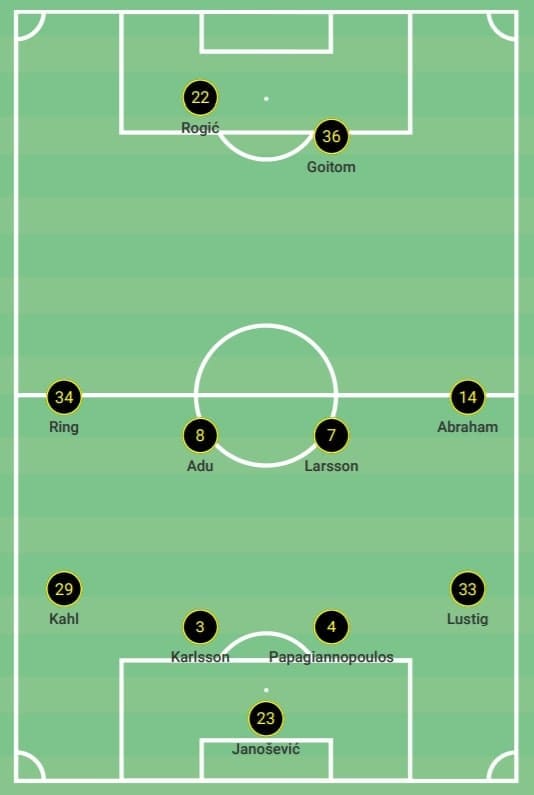
The above 11 players were the regular starters of Grzelak. The Poland-born coach preferred to play his team in a 4-4-2 recently, also shifting to 4-3-3 or 4-2-3-1 in some games. The major differences of this position would be the role of Filip Rogić or Eric Ring, who could operate at the midfield, at the flank or playing with Henok Goitom.
Since Karol Mets left the team to join Al-Ettifaq, Sotirios Papagiannopoulos has established as the regular partner of Per Karlsson. Meanwhile, Mikael Lusting was sometimes replaced by Robert Lundström if the manager rotated the team. Eric Kahl is the first-choice left-back.
Offensive organization
In the game against Mjällby AIF, AIK have shown more patience to construct the attack by moving the ball on the ground. However, complex positional plays were not the style of Grzelak’s team, who was trying to avoid losing the ball in key areas of the pitch. Therefore, plays were more direct often and this suits the traits of players.
The effects were clear from the below ball possession losses graph. As shown, the team did not lose the ball always, which would lead to countless transitions. Instead, even in the attacking half, Gnaget still gave away the ball less than league average. Apart from understanding the avoidance of positional plays, the distribution of ball possession losses also hinted AIK tended to attack flanks. Zone 8, 11, 14 , and 17 only composited 7.5% and 6.9% of the sum, while laterally all figures from both flanks exceeded 10%.
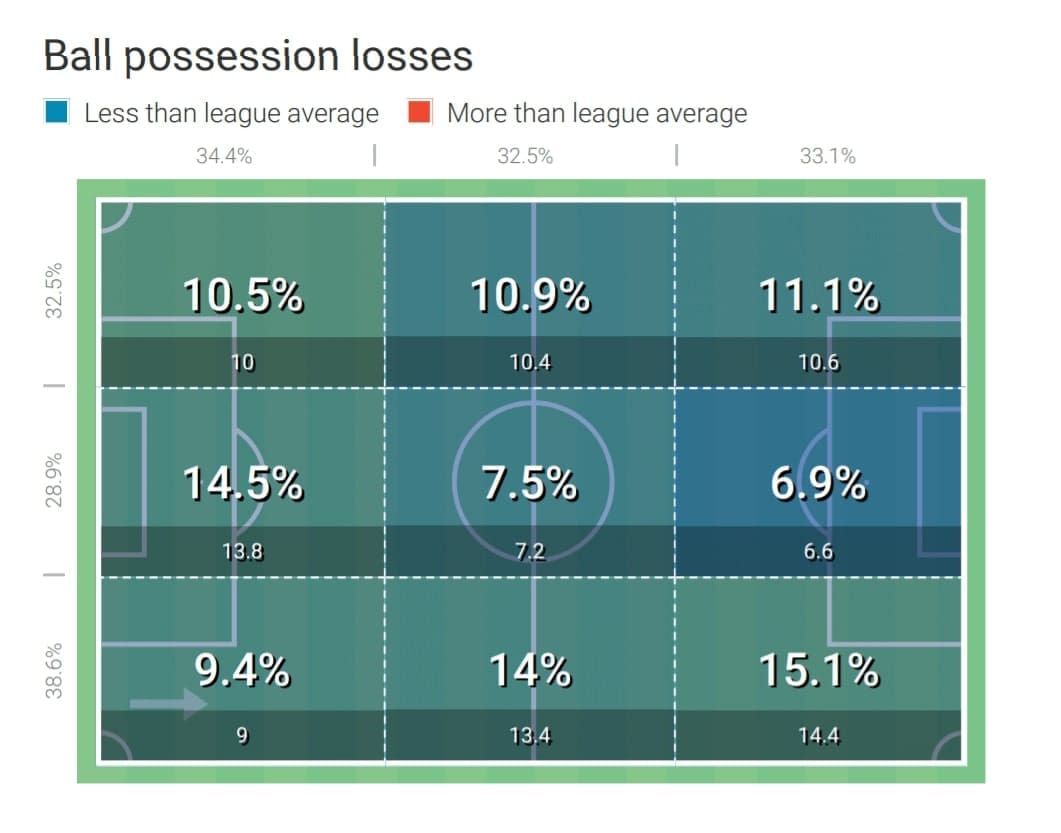
Another key element to avoid giving away the ball in critical areas was to avoid unnecessary dribbling. Particularly, players at the AIK backline did not possess flair liked former Manchester City and Barcelona star – Yaya Touré, who could bring the ball from one penalty box to another.
Therefore, the offensive organization of AIK relied on passing instead of dribbling, especially at the centre. The below dribbling graph of the team shows only 2.8% dribbles occurred near the central circle, which is an insignificant figure compared to 10.1% on the left. This was because of Kahl was given more freedom to bring the ball forward, while Enoch Kofi Adu was not an inevitable part in the build-up.
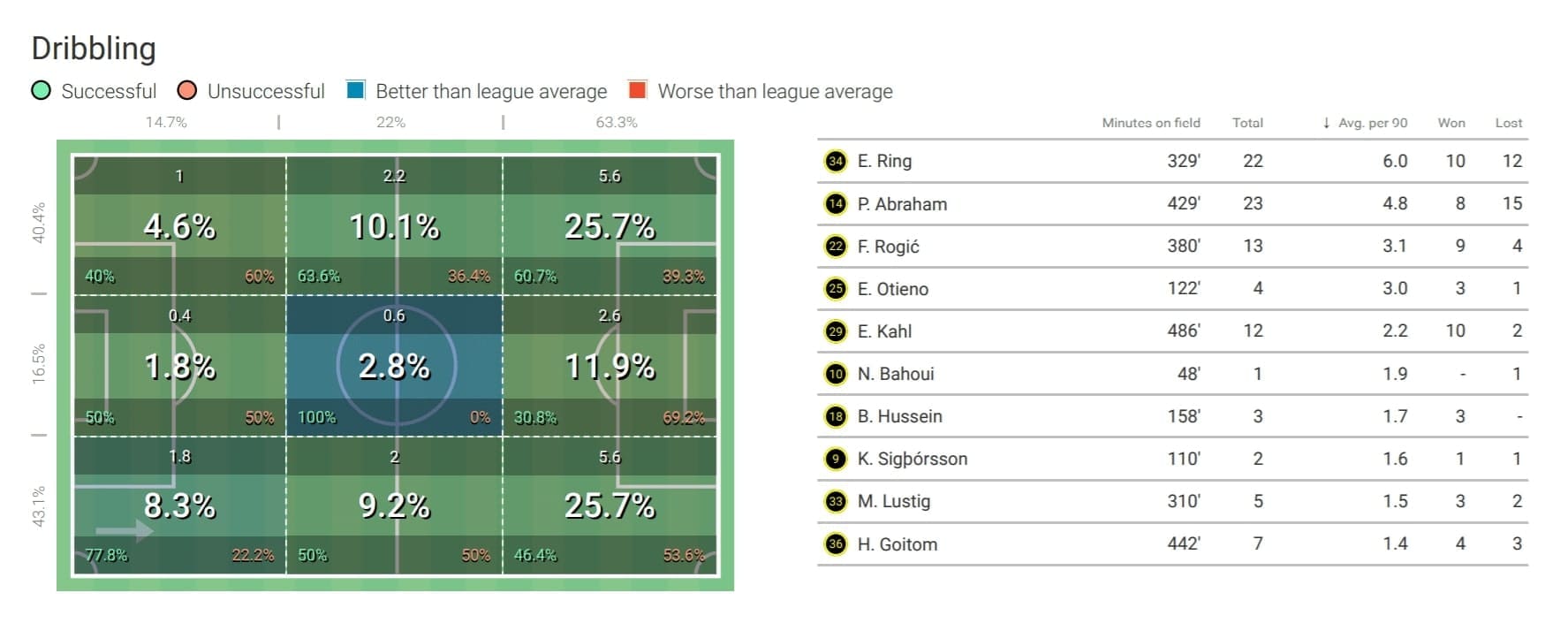
The below example shows the general structure of AIK in the first phase. The build-up shape varied from a 2-2 to a 3-1 as Sebastian Larsson could flexibly drop at the half-spaces. Also, Adu could drop between the centre-backs to create a temporary back three, so the wide centre-backs could connect the full-backs. Another variation of the build-up was a 3-2 shape, as Kahl stayed relatively deeper but wide, as a leeway to progress the ball.
The full-backs should stay wide to provide the width, as Lustig reached the touchline make the pitch as big as possible. To avoid a crammed wide zone with verticality, the wingers normally stayed narrowly at half-spaces. However, spacing and movements issues of the midfielders hindered usage of third man combinations at the centre. That verticality at the centre relied on individual dribbling to further develop an attack.
If passing the ball to the full-back, the major issue was the pass might go to the wrong foot. The receiver would need to drop slightly to get the ball, inviting the pressure from opposition wide player(s). Therefore, playing short was not the most effective strategy of the team, hence, unnecessary.
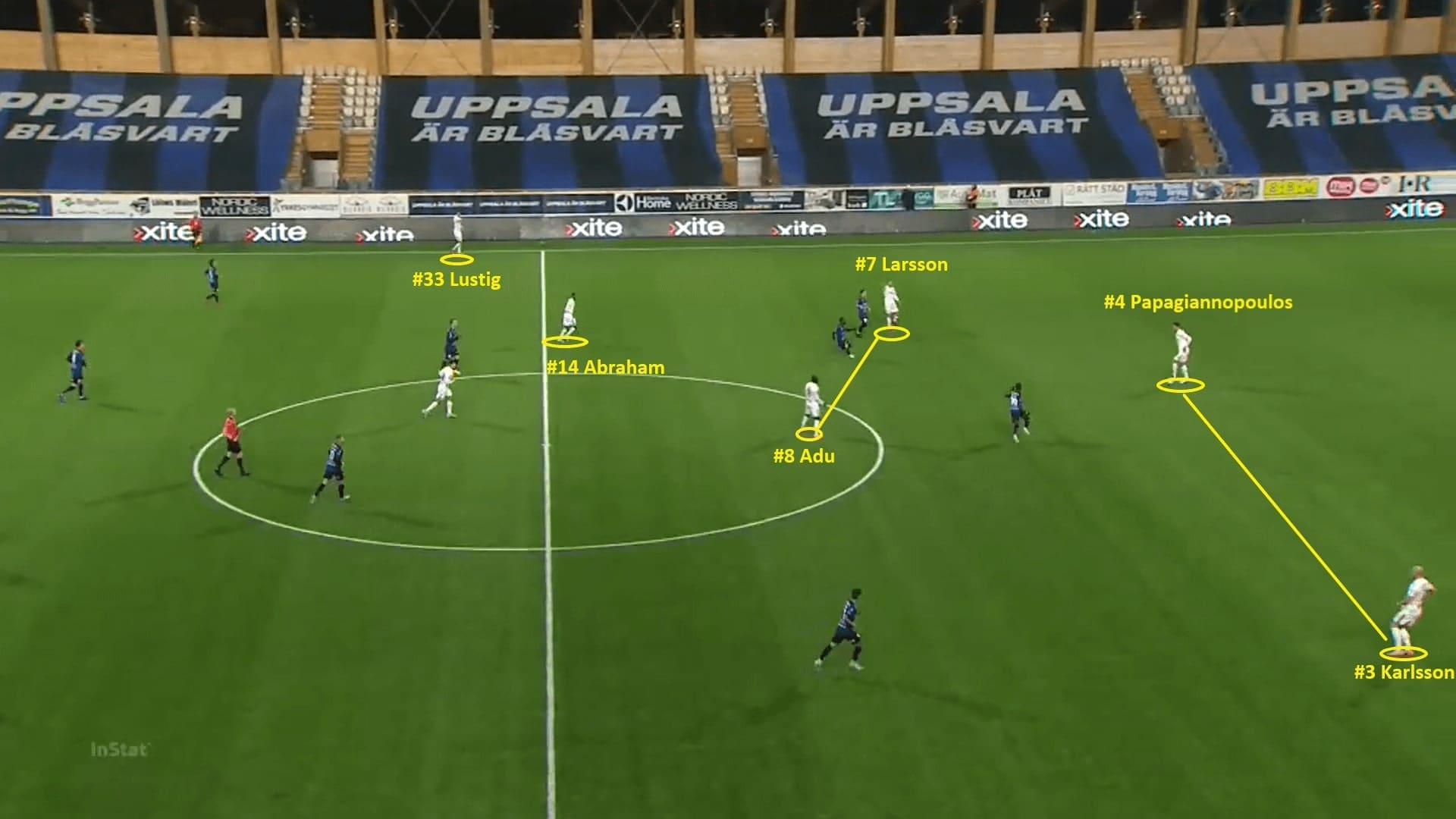
A very important element that helped AIK to enter the final third was the manipulation of the opposition full-backs. Usually, the full-backs were tasked to mark the wingers. This was one of the reasons which Grzelak wanted his wingers to play narrowly, opening wide zones for the full-backs. Also, moving at the right timing could fix the attentions of full-backs, manipulating their positions for the sake of greater spaces behind.
To provide passing options, the front three – Goitom, Ring, and Paulos Abraham would drop or use reversed movements. The most important was the presence of a runner who attacked spaces behind the defence. It could be a midfielder, or a full-back to make the deep runs. Abraham did well to keep the left-back narrow at the half-spaces, allowing Lustig to attack the entire wide zone. AIK definitely possessed good passers (Larsson) to play the diagonal balls into spaces, this pass should reach the receiver’s front foot to seize the momentum of the attack. Much better than the CB-RB pattern.
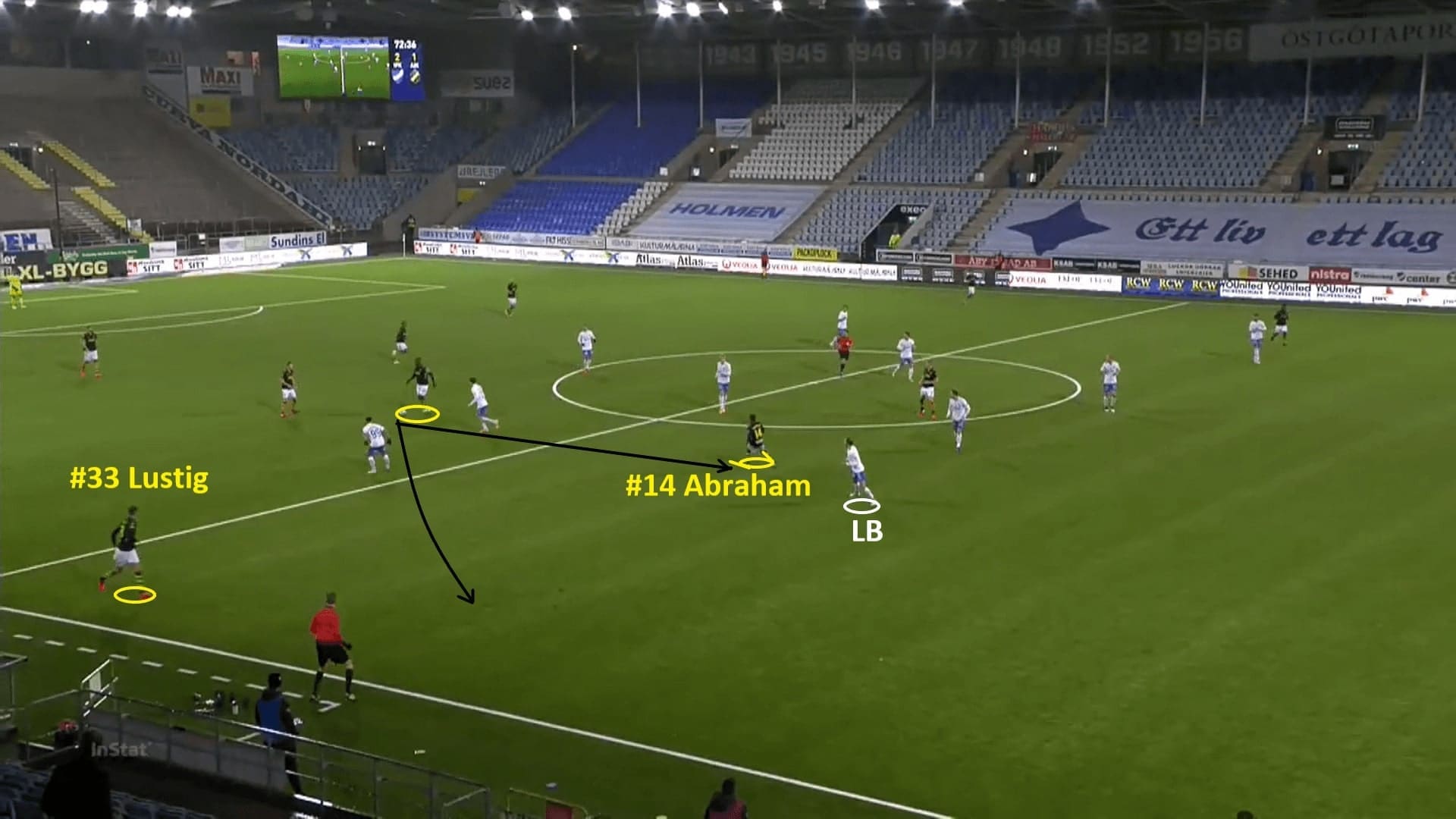
Wingers moving to half-spaces were not the only strategy for the team. If playing in a 4-3-3 shape, the trio was Larsson, Adu, and Rogić. The shape at the midfield was a 2-1, Larsson and Adu were the base while Rogić operated higher. In that advanced role, he should attack depth constantly, run into spaces created by wingers.
On the left, Kahl was competent to release the depth runners by playing lofted passes into spaces behind the full-backs. On the right, it was Larsson’s job to release the right-back in spaces. The below example shows the left-winger dropped to the wide zone, taking the IFK Göteborg right-back out of position. Spaces were created because of the Ring’s manipulation, while Rogić was quick to spot that area, being released by his teammate.
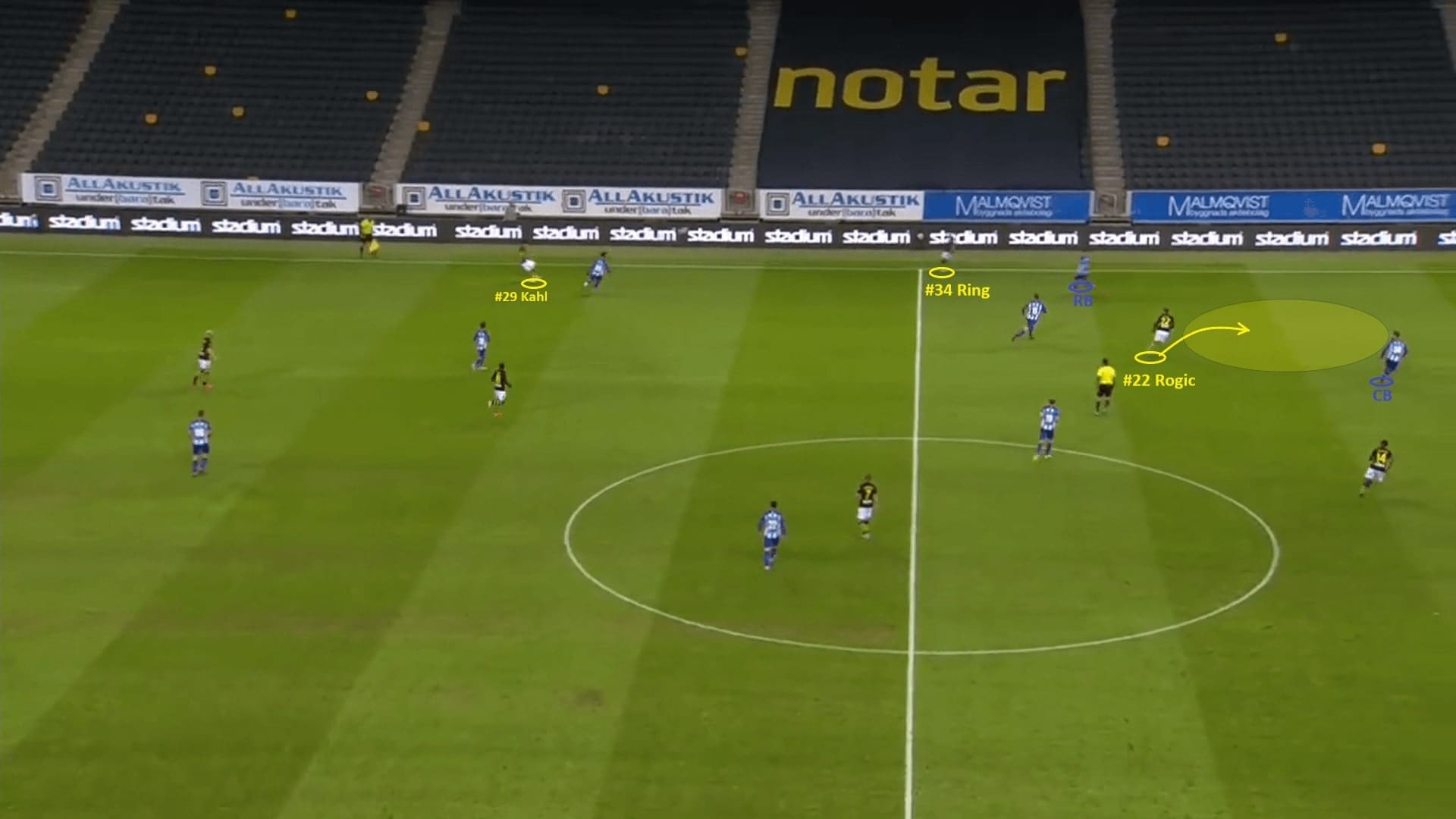
Direct plays, second ball structure, and crossing
On more occasions, when the oppositions were pressing high, AIK seldom took the risk to circulate the ball at the backline. Bypassing the defensive block directly to the front players was the preferred approach of Grzelak. To maximize the impacts of this approach, a designed second ball structure was enforced.
When taking goal-kicks or indirect free-kicks, the shape was 3-3-1-1-2, Goitom dropping as a target. Instead of releasing the third man by setting the ball, the former Valladolid striker tended to flip the ball. The function of the “2” layer was to run into spaces behind diagonally, searching for the second ball while facing the opposition goal. In case the delivery was not meeting Goitom or a third man was needed, Rogić would appear to help.
In open plays, forced long balls were more chaotic the dead-balls. The 3-3 layer might not be able to stay compact given the fastness of the game. However, the 1-1-2 structure was an unchanged part, commonly seen in AIK games.
Below was an in-game example. If Goitom was dropping to head the ball, very likely a centre-back would follow. This generated horizontal gaps at the backline. Nabil Bahoui was looking for the flip by entering spaces created by Goitom diagonally.
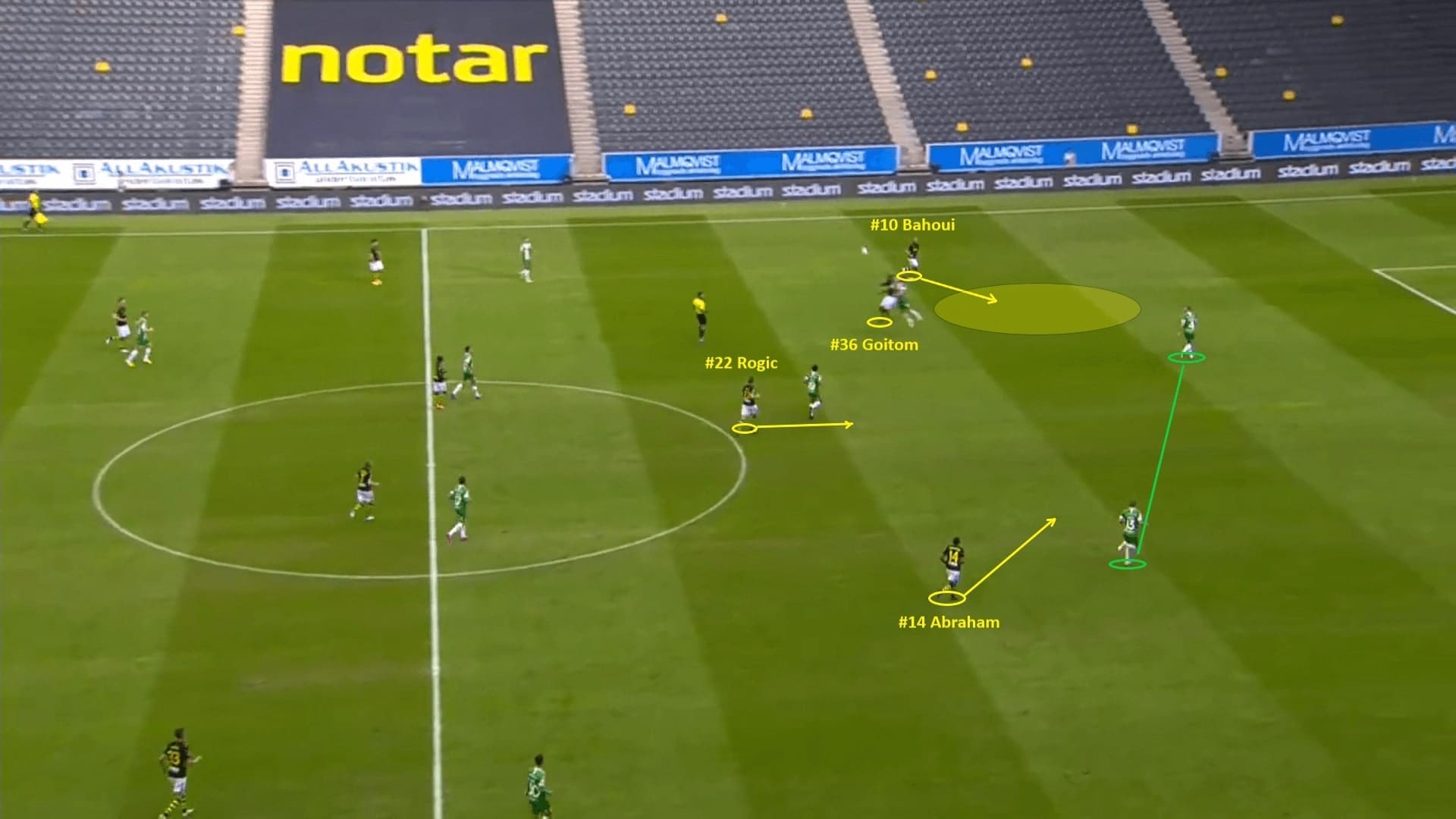
The below board shows a preferred pattern of AIK’s attack when constructing from the right flank. To further elaborate on the Larsson-RB-RW pattern, potential flows of the attack were demonstrated (yellow: movements; black: passes). The first case is to find the right-winger by passing to his feet, before he makes the move to attack depth. Those situations were difficult to develop an attack as the receivers must take on the defenders alone, dribbling towards the centre.
The other case was better, mostly ended up with a cross or winning a corner. It was a supportive inside-out run from the winger. By this move, a viable passing option was generated for the right-back. Sometimes the winger could return the ball to the right-back to cross from zone 15 as well. If the right-winger picked a good starting position before the run, he should begin from the left-back’s blindside, who often went wide to close the AIK right-back.
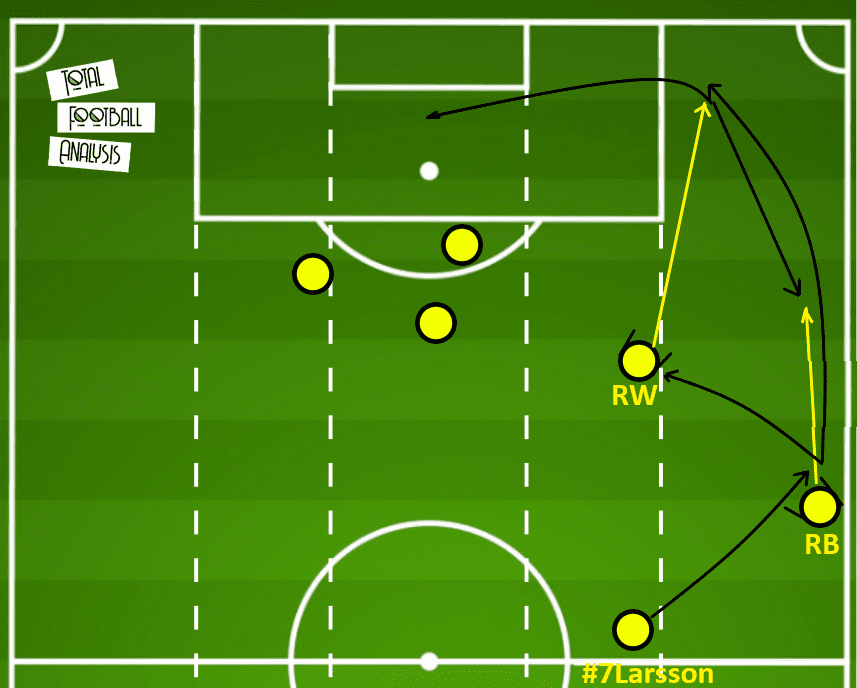
AIK also had dynamic strategies to attack the penalty box during the crosses. The most ideal situation was to place three players in the zone. When reached the wide zones, assumingly only one winger moved to the outside to support the right-back. The remaining two of the front three shall stay at the centre for the cross. Here, Goitom and Ring were available.
The best part of this setup was the timing and the dynamism of the runs. Goitom was the striker, he was most likely to make the first and early movements towards the six-yard box. This should also force the centre-backs to retreat together. Then, spaces were created for the advanced midfielder, who could make a late run to attack any free area – Rogić below.
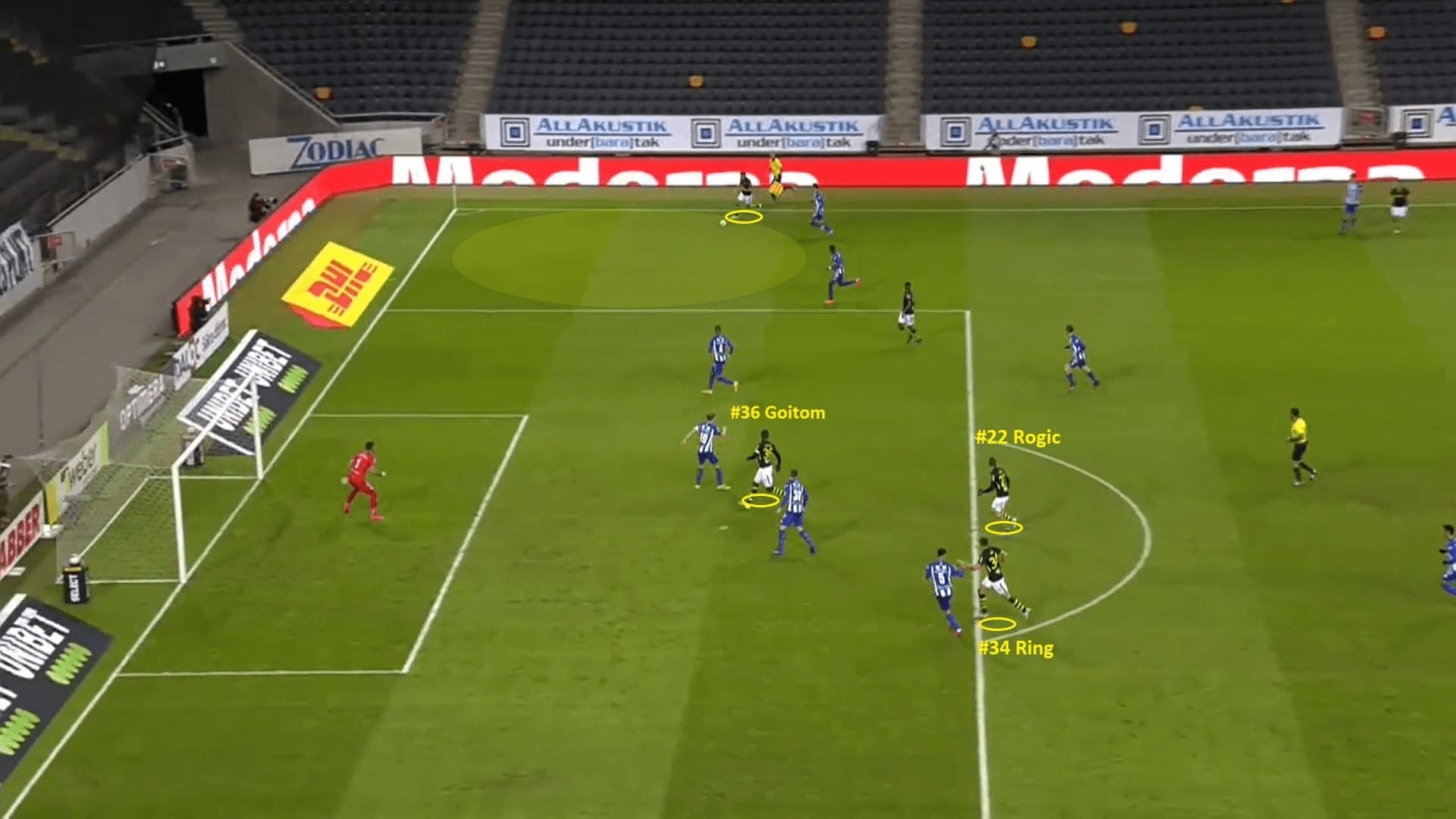
Goitom was more than a target man, sometimes he moved out of the penalty box to receive the ball. Therefore, at least a winger should provide the offensive height to manipulate the positioning of the backline. The role of Abraham and Goitom exchanged below, now, the number 14 was the striker while the 36-year-old player was at the right-winger position. The same requirement also fits the partner of Goitom if the team started in a 4-4-2.
Similar to the above case – Abraham to make the early movements into the penalty zone. This time, Larsson was the player to run from deep.
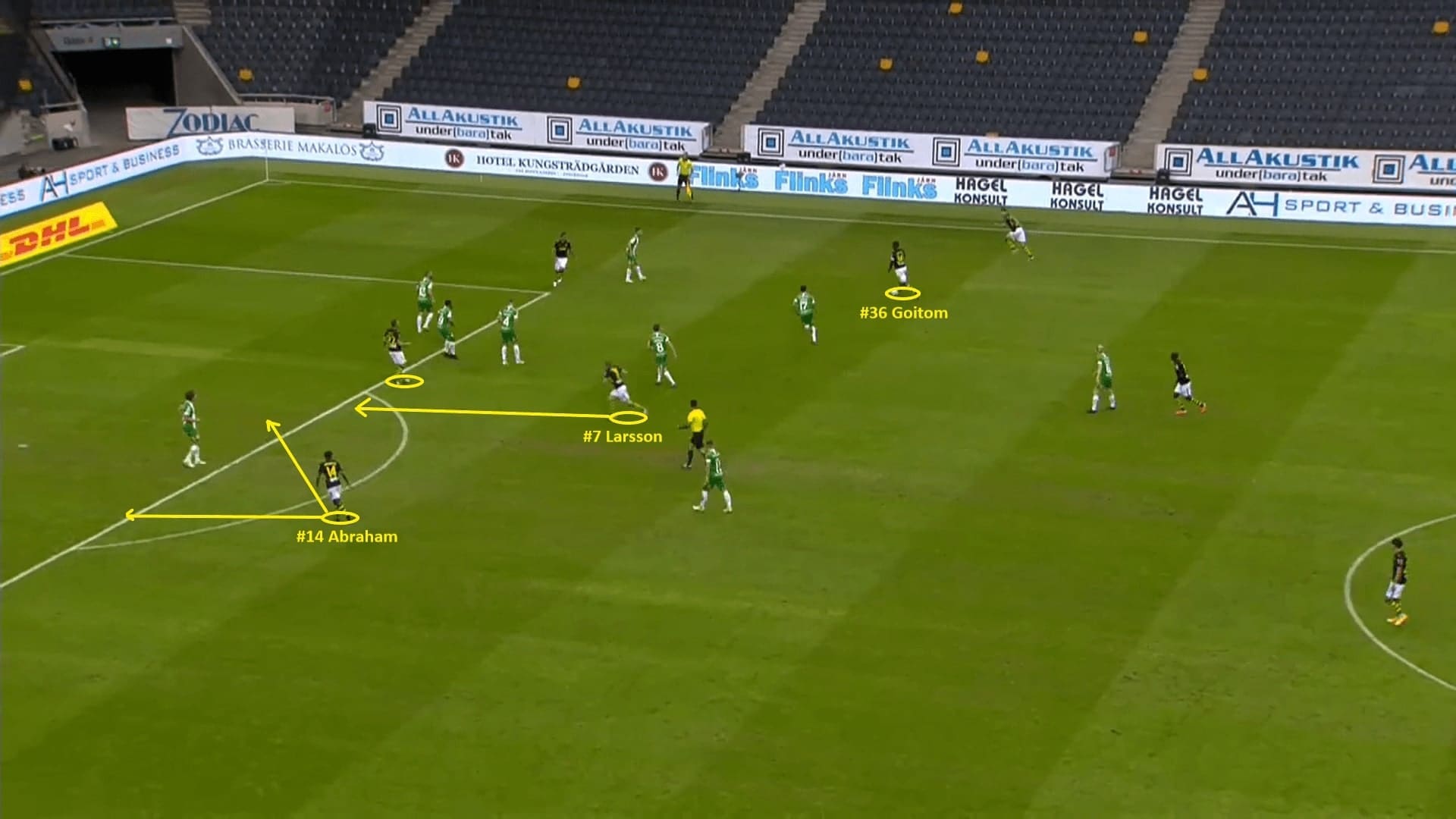
Defensive style of play
Pressing system
AIK were not the most aggressive pressing team in Allsvenskan, but when they did, the players coordinated with each other well. The system was zone-oriented, mainly the front players were pressing.
Pressing a back three was straightforward when the team was playing with a 4-3-3, as the front three perfectly match the defenders. However, when the shape was a 4-4-2, sometimes the wide centre-back found himself as a free player to progress plays.
The below example demonstrates the pressing shape, a 4-4-2. Usually, AIK players stayed centrally to overload the centre, while the wingers tried to protect half-spaces. Here, the priority of Ring was to narrow the vertical passing lane of the centre-back, forcing the ball to the right-back, then, began to press.
When adjusting positions of midfielders, horizontal gaps were still large at the four-man midfield. If the opposition attacking players dropped into those spaces, AIK full-backs must tightly follow the opponents to apply pressure on the closed body.
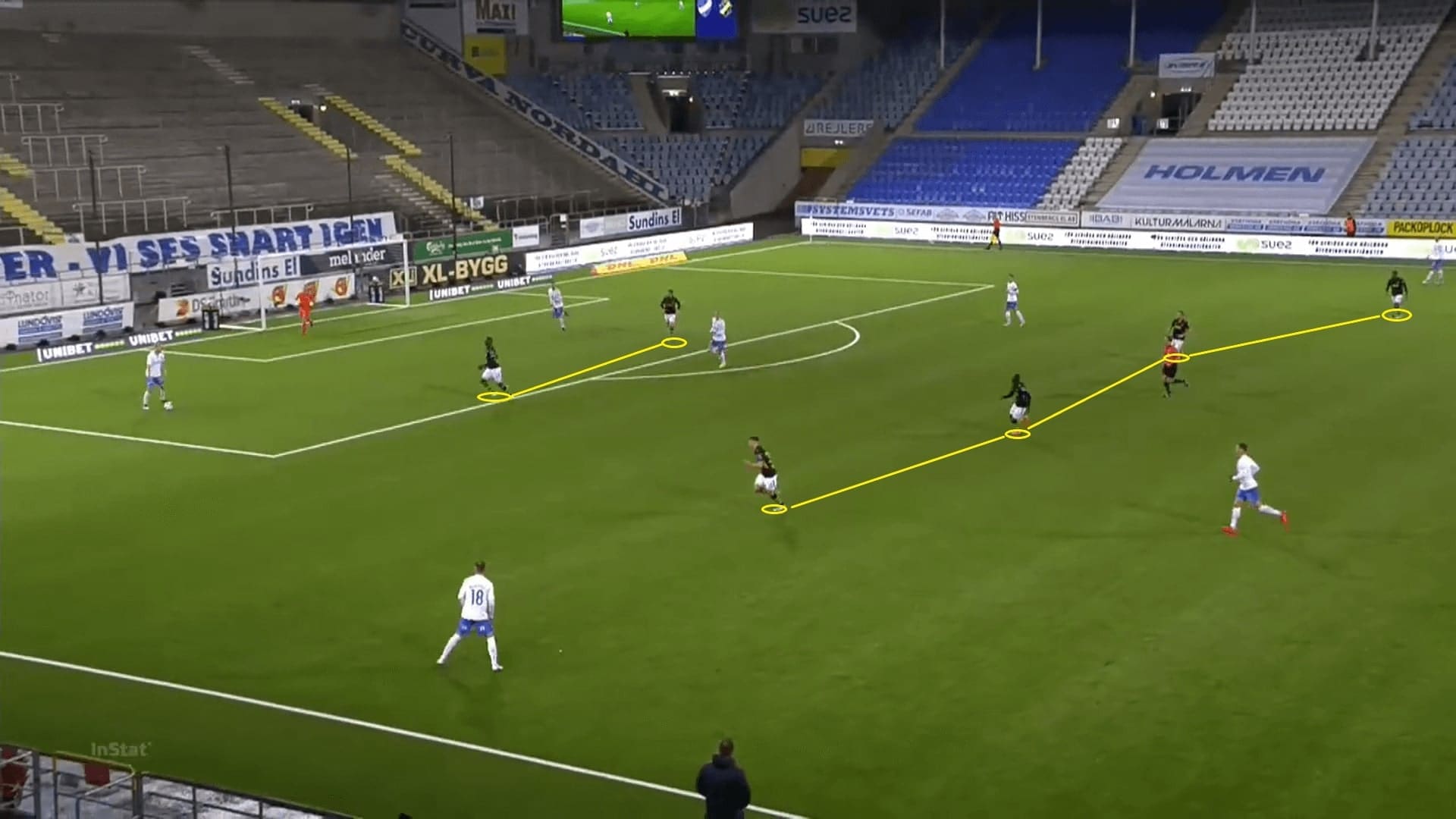
Given the close proximity at the centre, the opponents were likely to develop the attack at flanks. Therefore, how to press at flanks was the key to win the ball back. The vertical distance of the first and second line was huge initially, sometimes the AIK midfield was underloaded as the centre-backs seldom stepped up to the midfield.
The trigger was often a lateral pass from one centre-back to another or the wide pass from the centre-back to the full-back. The most ideal case was either Larsson or Adu staying deeper to protect the centre-backs as an additional layer. Thus, the strikers should always try to cover the midfielder of the attacking team when the wingers pressed the full-backs.
The below scenario was a summary of the above instructions. Göteborg had a 3 v 2 midfield overload, so the striker was trying to cover one option to create numerical equality. This would allow Larsson to defend deeper in the central circle. It was easy to trigger long passes as AIK only pressed high against teams who were not good at playing out from the back.
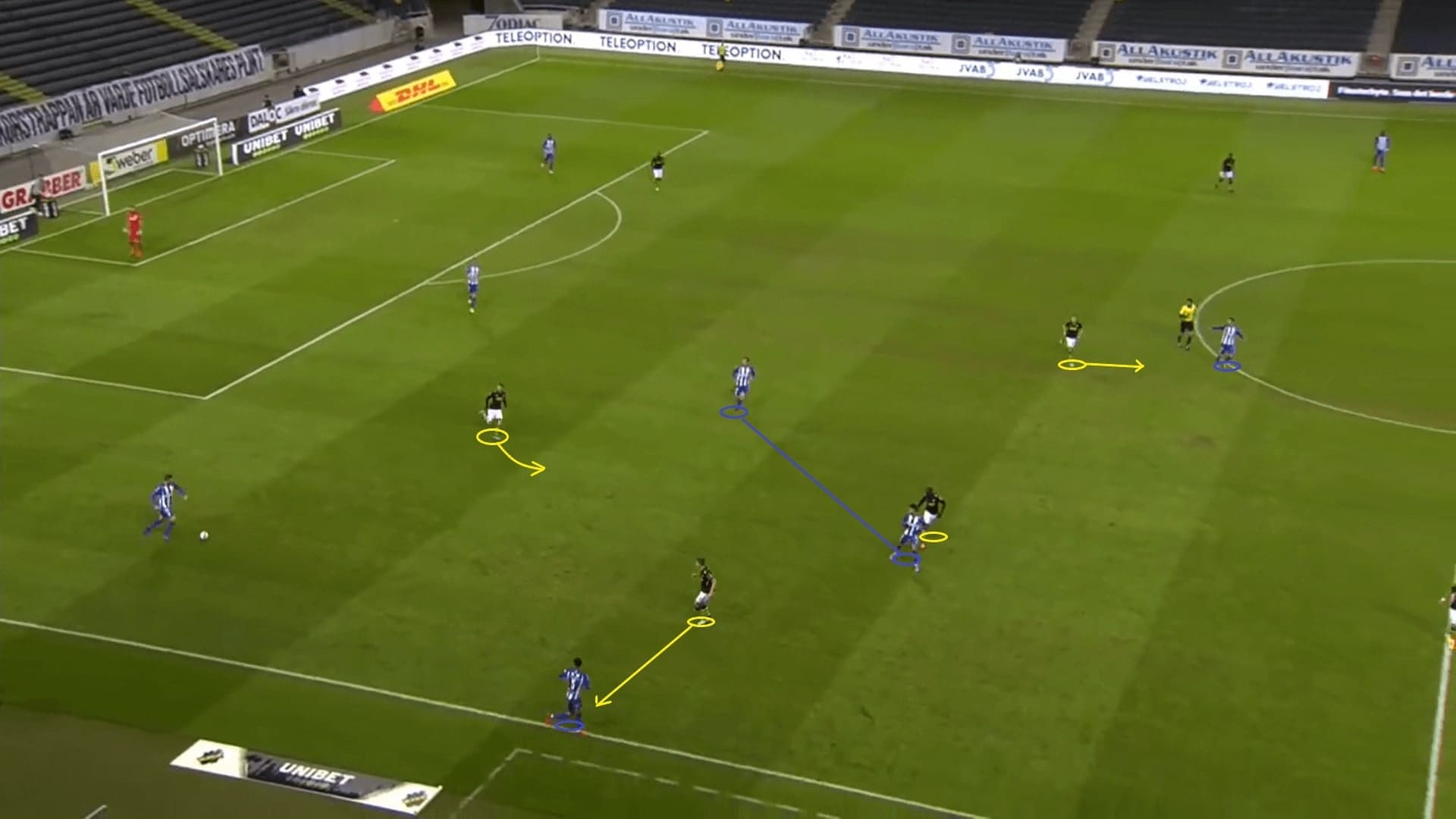
Even the attack was developed nearer to AIK’s half, the same concepts are applied to press flanks. Full-backs and wingers were tasked to press, moving wide while the midfielders should provide the defensive cover by horizontal shifting. The midfielder would have to read the pass to intercept the ball, as Grzelak expected his centre-backs staying together to defend runs or the target man.
Here, the wingers were pressing sideway – Kahl and Bahoui approached the targets simultaneously, forcing a pass. Adu was the ball-near midfielder to shift, read the pass and intercepted.
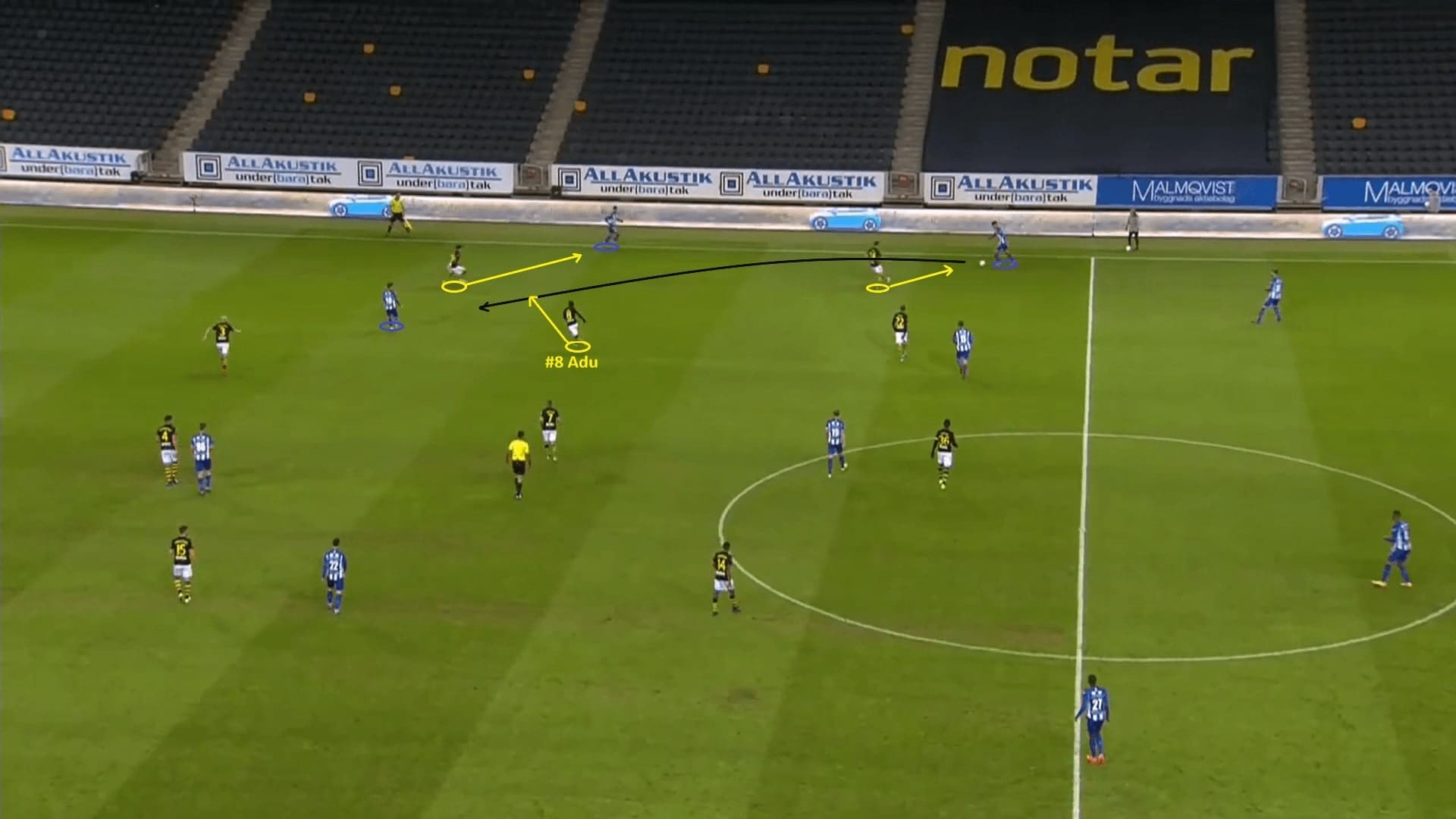
Defensive block and shifting
When facing stronger opponents such as IK Sirius and IFK Nörrkoping, Grzelak opted for a more defensive approach. AIK would sit in a midblock to maintain a compact shape, forcing the oppositions to play in tight spaces if they were penetrating centrally. Some ideas, including zone-oriented and shifting, were unchangeable, just liked the pressing scheme.
The midblock was also in a 4-4-2 shape. Frontline players should use the body orientations (facing sideways) to decide the flow of the ball, as shown in the below image. The attack should stay in either vertical half unless the offensive team reached the opposite side by a diagonal cross-field pass.
The wingers still prioritized to cover half-spaces, even at the expense to leave the full-backs unmarked initially. This was the same concept with the press – to force a wide pass (trigger to press), then, go for it. Ring was preparing to press below, but before of that, he narrowed the vertical passing lane with Adu.
Since Adu adjusted his position, a midfielder was less accessible at the centre. In those cases, it was important to believe Larsson was covering. The defence emphasized on shifting horizontally, as the former Sunderland player would move across to cover. Meanwhile, the central defenders should not step up easily to avoid players exploiting spaces behind.
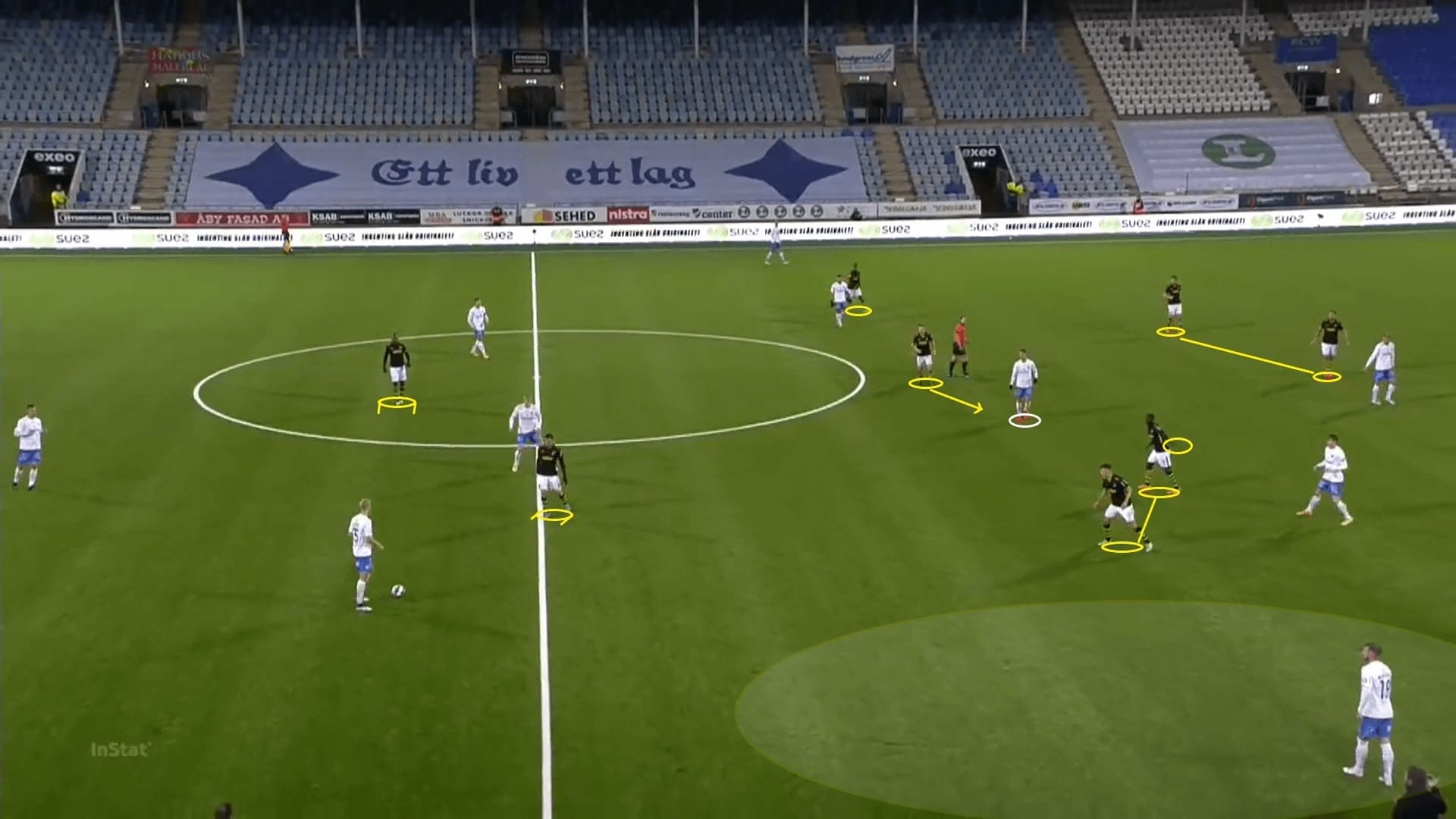
When successfully forcing the opposition to guide the ball wide, AIK players would need to defend the wide spaces a lot. The players must communicate to identify the tasks and defensive duties on the pitch. Spaces would be available at the outside of the pitch when the full-backs stepped up early.
On most occasions, the ball-near midfielder or the pivot should get into those spaces to provide the defensive cover, also at the half-spaces. Adu was covering the run behind Kahl below. Meanwhile, the centre-back, Mets slightly pushed higher to defend the target. Therefore, another midfielder – Larsson had to get into the box to cover spaces between the centre-backs.
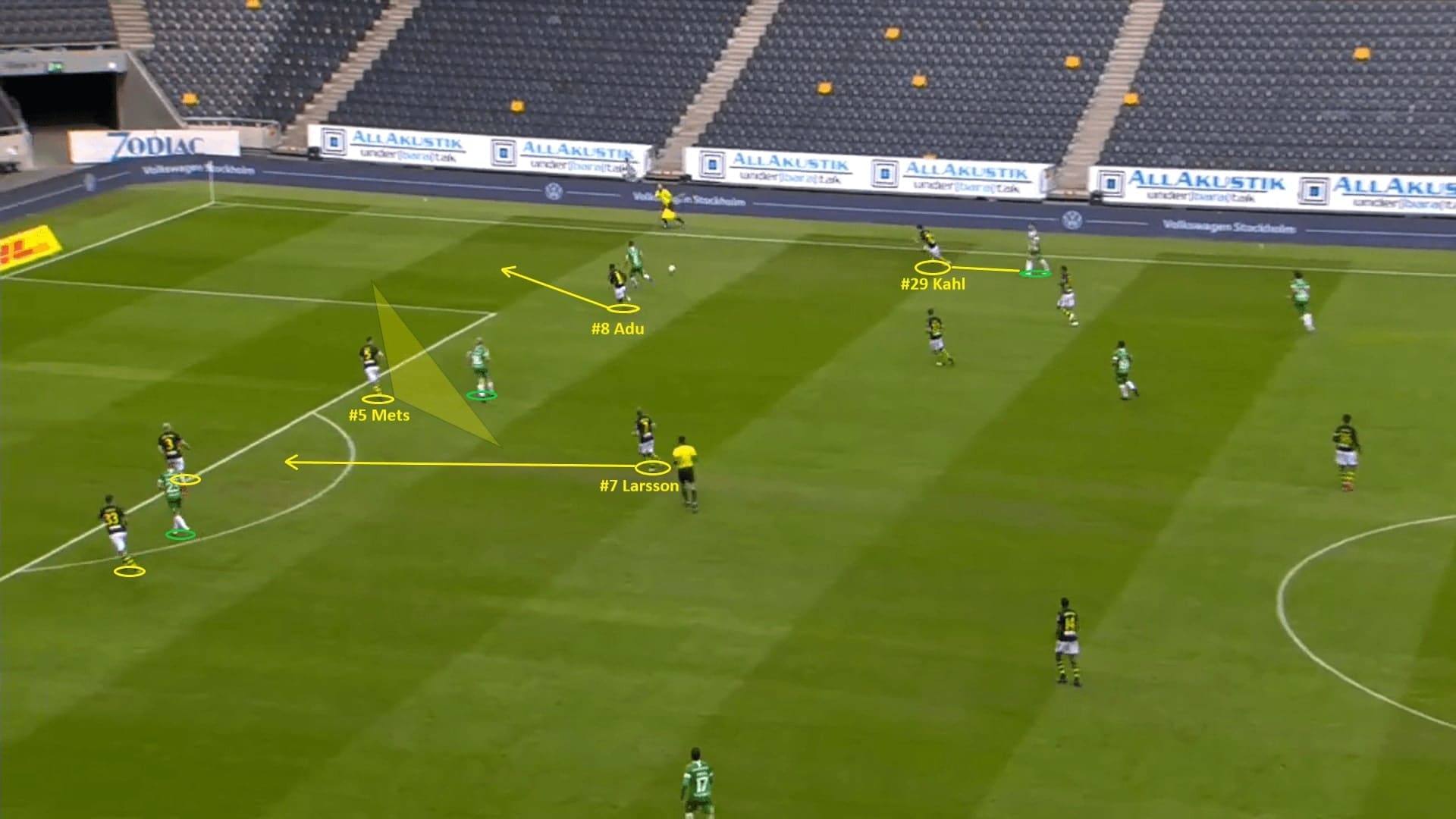
When playing in a 4-3-3, the team has one player more at the midfield while only one player up front, which is conducive to the defence. When defending the wide spaces, they could provide multiple challenges, even the dribbler beat the first marker, he might not beat the second and the third.
This was an approach to keep the centre-backs inside the penalty zone, who were better when contesting for the crosses or air balls. The job to defend out wide and the relative half-spaces left opened should be covered by the midfielders. Here, Adu and Rogić covered those spaces early, when Kahl was dribbled past, they were there to deny the cross. At the meantime, AIK got enough numbers inside the penalty box.
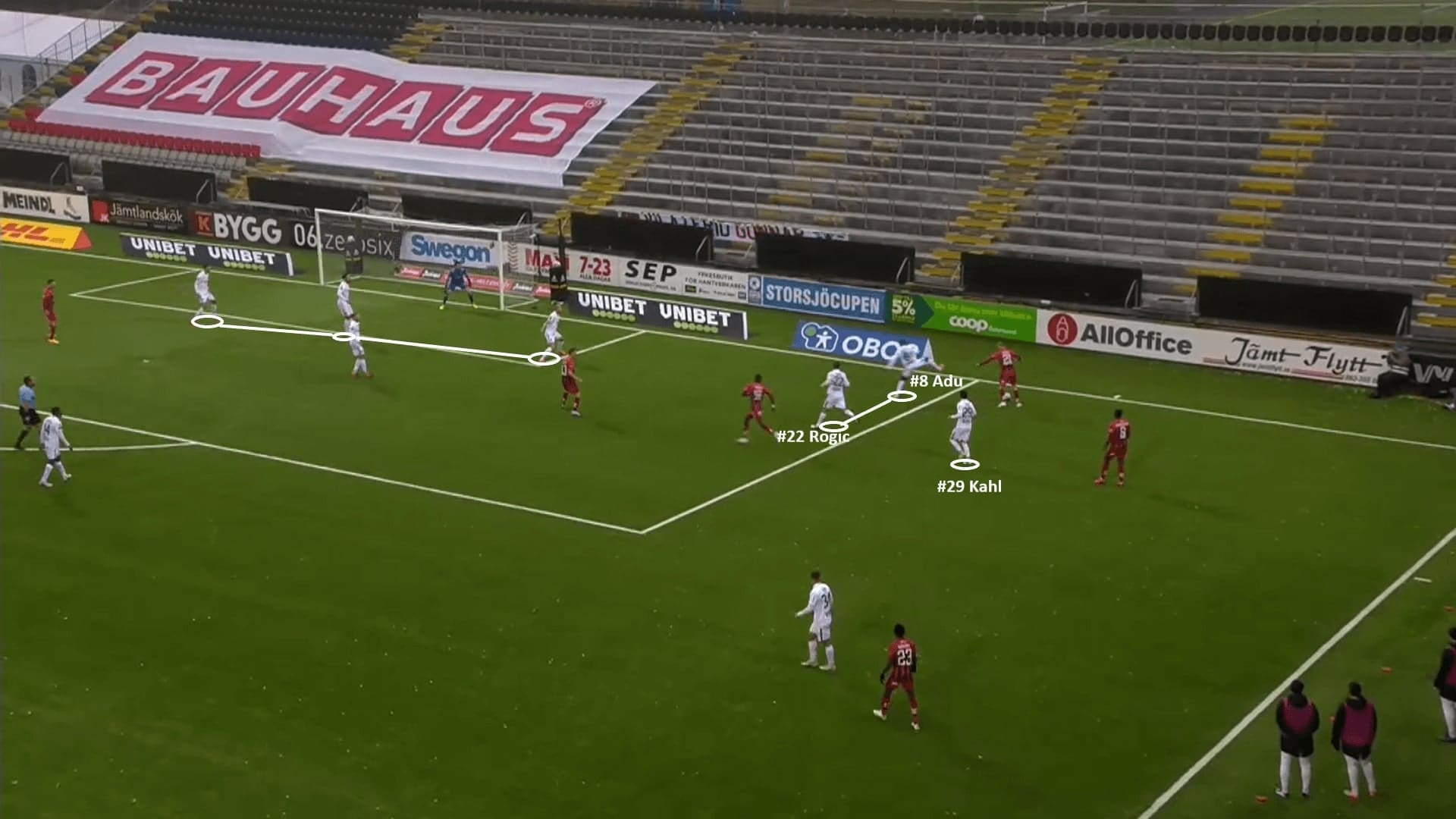
When defending in the penalty box, it would be more ideal to defend with two layers – one for the early movements while the other one to cover spaces or the deep runs. The defenders were the deeper layer to defend the crosses, while spaces around the penalty spot should be covered by the midfielders. Therefore, disciplinary and defensive awareness of Adu and Larsson would be vital.
Another point to note was the strategy against a two-striker system, as Hammarby IF played in a 3-5-2. The approach of Grzelak was to keep the three of the back four at the centre, creating a 3 v 2 “plus one” advantage on the strikers. They largely kept Aron Jóhannsson and Gustav Ludwigson in their pockets. However, the underlying issue would be the far post coverage when the right-back defending narrowly with the centre-backs, which was shown in the below example.
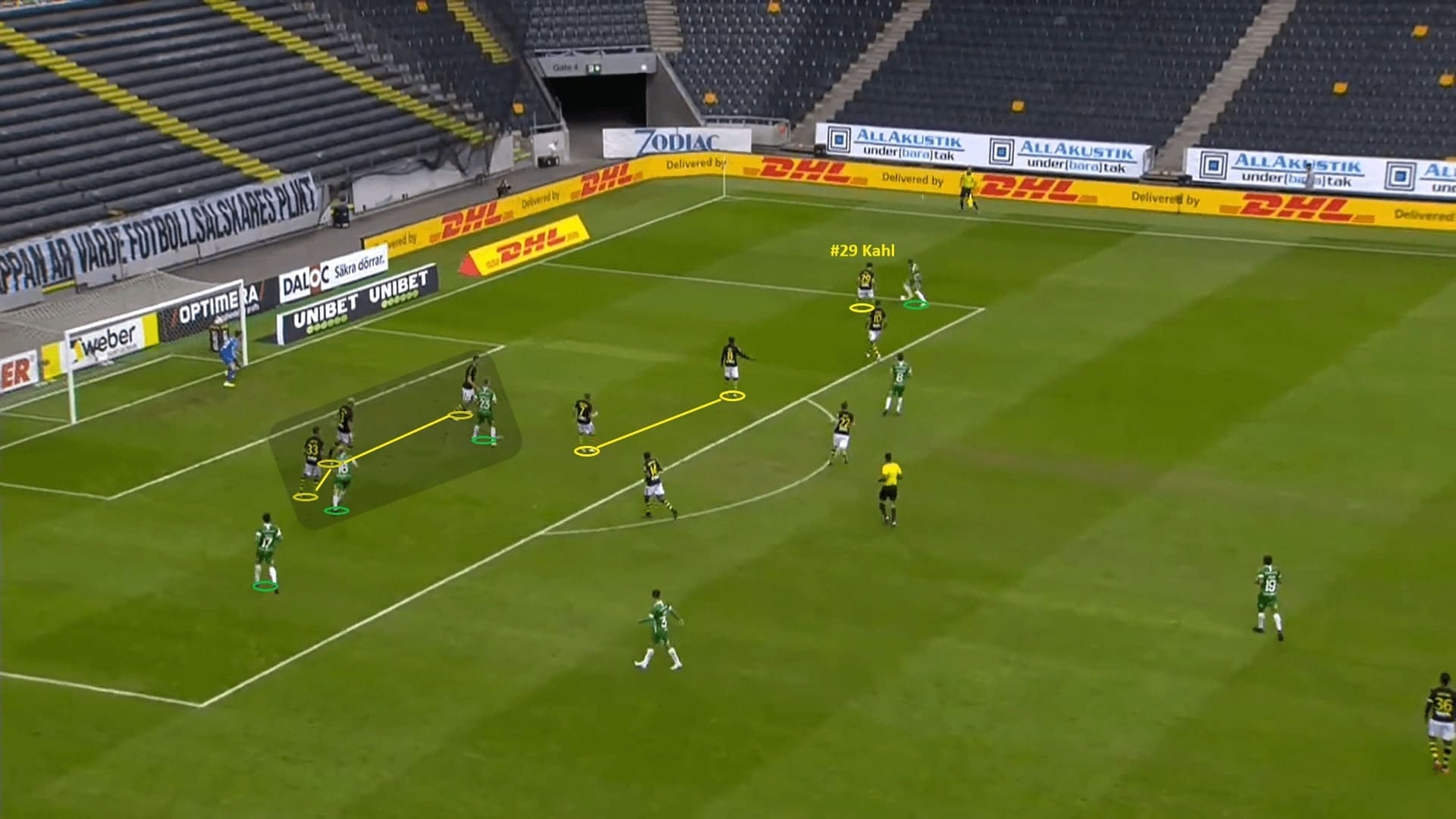
In some cases, when Grzelak feels his team needed to defend a lot with a low block, he even threw out one more defender and instruct his team to defend in a back five. In the final stages of the game against Östersunds FK, Panajotis Dimitriadis replaced Abraham as the additional defender, the team was playing in a 5-4-1.
Apart from enjoying an extra man at the defence, this was also a measurement to cover the far post issue as suggested above. The defence had better horizontal coverage in a back five so they could also defend the far side if needed, which was in the below image.
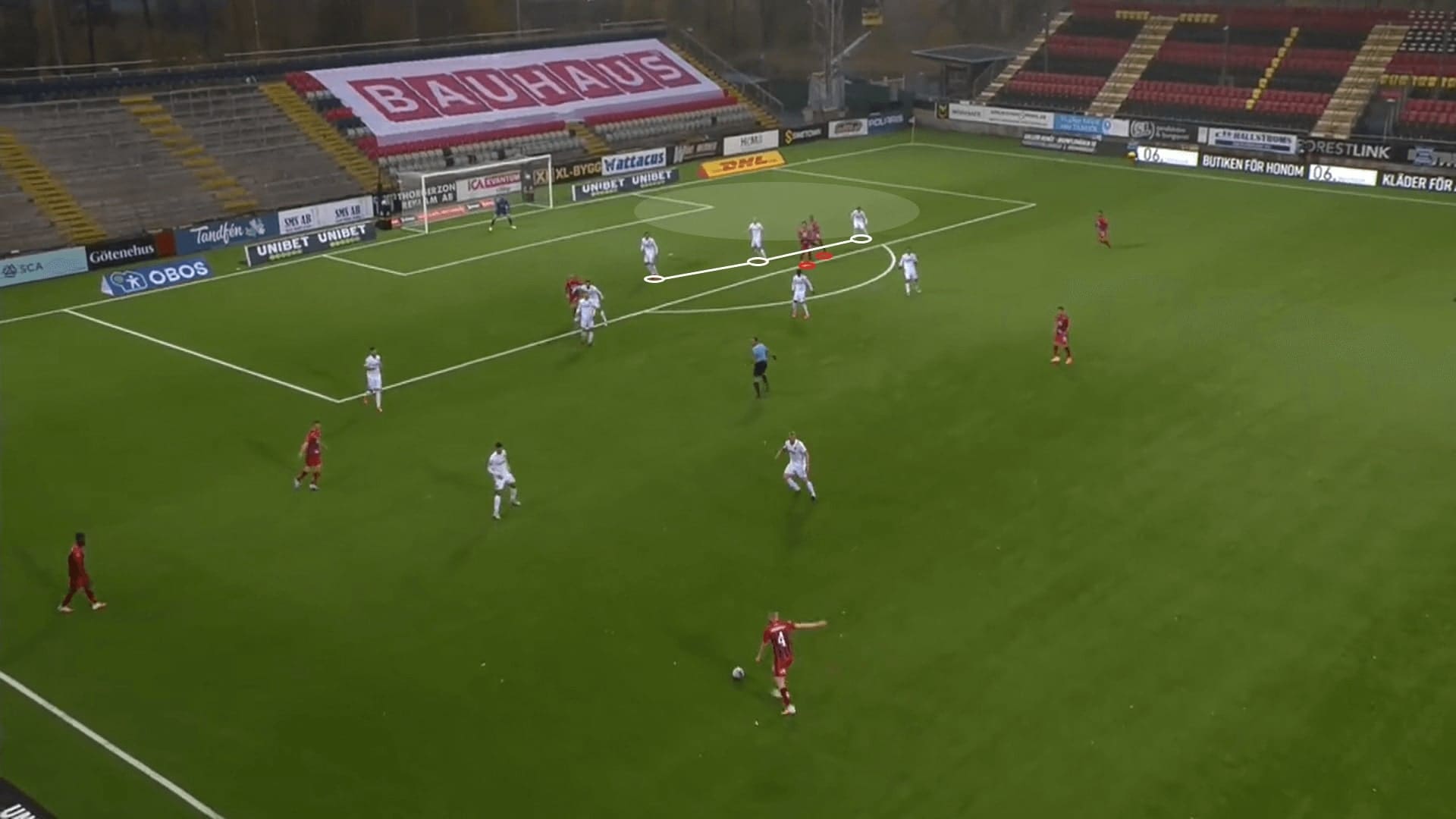
Final remarks
It was quite magical. Months ago, AIK fans were worrying about the future of the team because of unsatisfactory performance. After this strong run, we are pretty sure to see the Gnaget in Allsvenskan 2021. A 12-point margin with 4 games remaining, AIK will stay.
As shown in this analysis, Grzelak was smart to implement simple tactics. They were not complicated moves of positional plays, but all of them were designated by the coaching team, carried out by the hard work on the training ground. Apart from a collective perspective, several experienced squad members – Goitom and Larsson made impacts in key moments, were also vital to the improving results of the team.





Comments